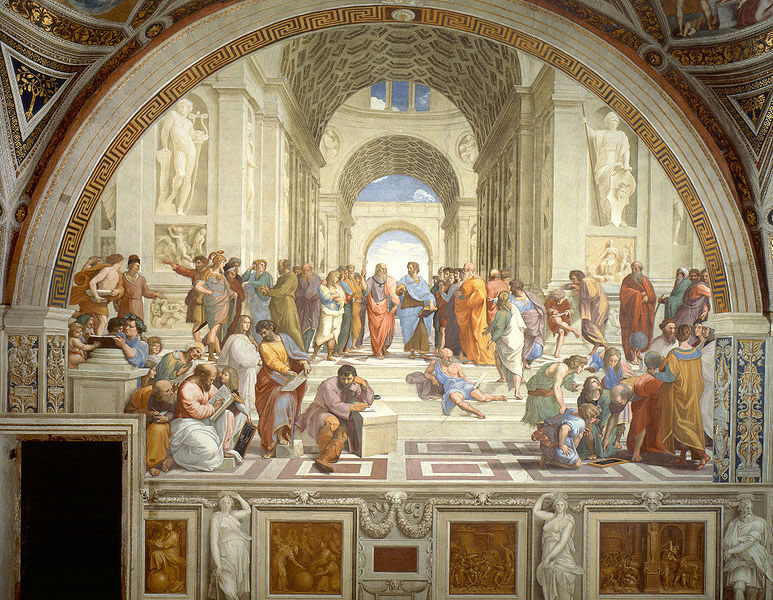| School of Athens | |
|---|---|
 |
|
| Artist | Raphael |
| Year | 1509–1510 |
| Medium | Fresco |
| Location | Apostolic Palace, Vatican City |
| Dimensions | 200 in × 300 in |
| 500 cm × 770 cm | |
| Famous Paintings by Raphael | |
| School of Athens | |
| Transfiguration | |
| The Marriage of the Virgin | |
| Resurrection of Christ | |
| Self-portrait | |
| La belle jardinière | |
| Ezekiel’s Vision | |
| The Sistine Madonna | |
| Madonna and Child with the Book | |
| View Complete Works |
School of Athens refers to a famous fresco painted by Raphael in the Apostolic Palace in Vatican City. The fresco was painted between 1510 and 1511 and is one of four frescoes painted by Raphael in the rooms now known as the Stanze di Raffaello. School of Athens was the second fresco completed in the room and depicts Raphael”s interpretation of philosophy as a branch of knowledge. Showing a gathering of Greek philosophers engaged in various activities, the fresco is considered a prime example of High Renaissance art and considered Raphael”s masterpiece.
Theme
School of Athens is one of a series of four frescoes painted by Raphael representing branches of knowledge. The frescoes, located on the walls of the Stanza, include images descriptive of philosophy, poetry, law, and theology. School of Athens is dedicated to philosophy as a path to knowledge, especially related to understanding causes to drive knowledge. All of the philosophers shown in the fresco traditionally sought knowledge through an understanding of root causes, tying back to the title and theme of the fresco. The overall theme of knowledge is integrated through Raphael”s frescos around the room but School of Athens is considered the best of the series.
The Fresco
The fresco itself includes 21 distinct figures set against a backdrop of a school. The figures are engaged in conversation, work or games. All of the figures are male and are believed to represent all significant Greek philosophers. The fresco also includes images of statues within the school displayed within the school. One statue is Apollo, the Greek god of light, archery and music, holding a lyre. The other statue is Athena, the Greek goddess of wisdom, shown in her Roman form as Minerva. The building itself is shown in a cross-shape with the figures in the foreground and the interior receding behind them. The figures are scattered across steps and walkways within the school and the fresco is framed with an arch decorated with arabesque swastikas. The fresco measures 200 inches by 300 inches with a tondo above depicting a female figure with a putti stating “Seek Knowledge of Causes.”
The Figures
The central figures in School of Athens are Plato and Aristotle. Depicted at the central vanishing point of the shown architecture, Plato holds a bound copy of Timaeus in his left hand and is shown as an older, wise, gray-haired man. In contrast, his student Aristotle is shown as a younger, handsome man looking to his teacher. Aristotle carries a bound copy of Nicomachean Ethics in his left hand and walks slightly ahead of Plato. The two central figures both gesture with their right hands but along different visual planes. Plato gestures upwards into the vault while Aristotle gestures horizontally ahead of the figures. Plato and Aristotle are deep in conversation while walking through the other figures.
The other figures shown in the fresco representing other significant Greek philosophers are not as clearly identifiable. While some are more recognizable than others, some of the figures may represent philosophers where no historical image exists. Raphael used iconography to represent those philosophers with no known visual image such as Epicurus. While Plato and Aristotle serve as the central figures of the fresco, the other philosophers depicted lived at various times and were not necessarily their contemporaries. Many of them lived before Plato and Aristotle and barely a third were Athenians. However, the compilation of famous Greek philosophers followed the intended theme of the fresco to seek knowledge through philosophy.
School of Athens continues to drive discussion and analysis among art historians and scholars. Insufficient information exists to validate whether Raphael received specific direction from Pope Julius II on the components of the fresco, how much philosophical knowledge he had or how much he may have been influenced by his contemporaries. Regardless of the background or direction brought to the fresco, School of Athens shows the depth of Raphael”s artistic talent, including the ability to integrate four different frescos to a connecting theme. Whether the fresco is considered an artist”s representation of philosophy or deeper meaning is associated to the various gestures and details, School of Athens continues to provide a beautiful view into High Renaissance art.